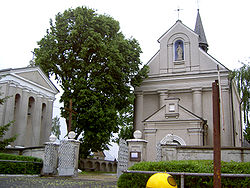Łaszczów
| Łaszczów | ||
|---|---|---|
| Town | ||

Parish church
|
||
|
||
| Coordinates: 50°32′N 23°44′E / 50.533°N 23.733°E | ||
| Country |
|
|
| Voivodeship | Lublin | |
| County | Tomaszów Lubelski | |
| Gmina | Łaszczów | |
| Population | 2,341 | |
| Website | Website | |
Łaszczów [ˈwaʂt͡ʂuf] is a town in Tomaszów Lubelski County, Lublin Voivodeship, in eastern Poland. It was re-established as a town on 1 January 2010, having previously had town status between 1549 and 1870. It is the seat of the gmina (administrative district) called Gmina Łaszczów. It lies approximately 25 kilometres (16 mi) east of Tomaszów Lubelski and 114 km (71 mi) south-east of the regional capital Lublin.
The town has a population of 2,341.
The history of Łaszczów dates back to 1549, when King Zygmunt August allowed Podkomorzy of Belz and Castellan of Horodlo Aleksander Laszcz to change his own village of Domaniz into a town of Prawda (named after Prawdzic coat of arms). The royal bill was signed on December 22, 1549, at Piotrków Trybunalski.
The town of Prawda was founded next to the village. By the 1570s, its name was changed into Łaszczów (after the Laszcz family). Łaszczów had Magdeburg rights, and during the Protestant Reformation, became important center of the Polish Brethren. It had a prayer house and a printing shop, which operated until 1603. Łaszczów was a regional trade and business center, but its prosperity ended after Swedish invasion of Poland (1655 - 1660). In 1702, the town was burned by Swedes, during the Great Northern War, and in 1745, Jozef Laszcz, owner of Łaszczów, initiated construction of a church and Jesuit collegium. In 1754 Łaszczów burned in a great fire, after which its owners ordered residents to build brick houses.
...
Wikipedia


